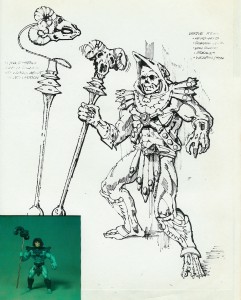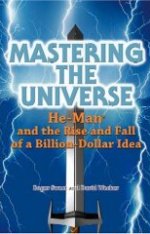Mastering the Universe: He-Man and the Rise and Fall of a Billion-Dollar Idea (Order from Amazon)
by Roger Sweet and David Wecker
Emmis Books, 2005
ISBN: 1578602238
I picked up a copy of Mastering the Universe when it was first published. Aside from flipping through a few bits here and there, I never sat down and read the whole thing through until a few weeks ago. The book is ostensibly an account of the creation, development, and ultimate fall of Mattel’s Masters of the Universe toyline through the eyes of toy designer Roger Sweet.
But if you take away anything from Mastering the Universe, Sweet would like it to be this: it was all his idea. And I mean all. As one reviewer of the book on Amazon put it, it reads like a court deposition in a case where the question is who created He-Man. Sweet backs up his claims by constantly citing specific patents, internal documents, and other paperwork that means little or nothing to the average reader (or indeed, anyone other than another Mattel employee).
For this reason, Mastering the Universe isn’t always an easy read. Sweet’s writing (aided by his nephew, David Wecker) is peppered with moments of bitterness, egotism, and defensiveness, not to mention a heavy helping of self-martyrdom. Oddly enough, in both its self-aggrandizing nature and its defensiveness regarding credit for MOTU, Sweet’s book shares certain similarities with Dream Doll, the autobiography of Mattel founder Ruth Handler, who claimed she was the sole inventor of Barbie.
 If Sweet’s agenda were simply to ensure credit was given where it was due, Mastering the Universe would be an informative, if somewhat dull, account of the origins of He-Man and the Masters of the Universe and the corporate shenanigans that went on behind the scenes. Unfortunately, Sweet is so self-aggrandizing I was more than a little annoyed by the end of it. He rarely acknowledges–or at least, rarely approves of–the contributions of others to the MOTU brand.
If Sweet’s agenda were simply to ensure credit was given where it was due, Mastering the Universe would be an informative, if somewhat dull, account of the origins of He-Man and the Masters of the Universe and the corporate shenanigans that went on behind the scenes. Unfortunately, Sweet is so self-aggrandizing I was more than a little annoyed by the end of it. He rarely acknowledges–or at least, rarely approves of–the contributions of others to the MOTU brand.
The book is at its best when Sweet lays off the agonizingly detailed accounts of corporate politics and describes the process of designing or engineering some new character or toy. I was particularly intrigued to read about the toys that didn’t make the line, such as the monstrous “Gygor” made by re-using the gorilla from the Big Jim Jungle Adventure set (just as Battle Cat and Zoar were made from Big Jim toys).
Part of the reason I was initially turned off by the book was that Sweet, who goes to extreme lengths to show how much of it was all his idea, nonetheless gets a number of facts about the line wrong, from calling Buzz-Off a villain to mixing up Kobra Khan and King Hiss (despite correctly describing Khan earlier in the book). Obviously, this is the sort of thing you really only expect us toy geeks to know and care about, and ordinarily I’d agree that being bothered by it is the height of nerdy nitpicking. However, if Sweet is trying to convince me he was the creator of MOTU, a little research and fact-checking would have gone a long way. As it stands, the lack of attention to detail makes the whole project a bit more suspect.
There’s a passage in the book that ironically makes the point:
Several months after He-Man’s introduction at the Toy Fair […] [Marketing Director] Mark Ellis issued a memo in which he gave the Marketing division credit for creating and masterminding [MOTU]. Denis Bosley, still VP of Preliminary Design, fired off a venomous reply memo clearly stating that his department–and he cited me specifically–had created the concept.
Unfortunately, he hadn’t checked the facts with me. His memo contained a few inaccuracies, which diverted attention in Marketing and upper management away from the point he was making. Instead of beating back the slings and arrows of outrageous misfortune, he was seen as misinformed.
Had Sweet made Mastering the Universe more of an account of how the line and its characters were created and less of a polemic about who deserves credit for what, I think it would be a much more enjoyable read for fans of MOTU. But really, it’s a memoir of Sweet’s experiences in the corporate culture of Mattel in the 1980s with MOTU as its focus. Had Sweet spent less space on (battle)axe-grinding and more on (accurately) describing the process of making MOTU, Mastering the Universe would be a must-have for every He-Fan’s bookshelf.
As for the book’s central theme: I believe Sweet’s claim that the initial concept for MOTU came from him. I no longer think MOTU was developed for the movie Conan the Barbarian and then changed when the film turned out to be too violent for toys. And I have no doubt Mattel was the nest of vipers Sweet makes it out to be. But I’m also sure there’s more credit to go around than Sweet lets on, and his constant defensiveness–and the inaccuracies regarding the toys themselves–only weaken his case.

